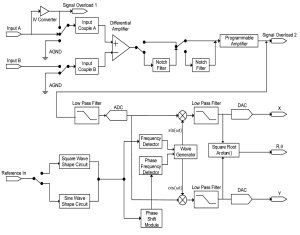The Saluki SE1022D DSP Lock-In Amplifier (Dual-channel) operates based on the principle of lock-in amplification, which is a technique used to extract weak signals from noisy backgrounds. Here’s an explanation of the working principle of the SE1022D Lock- In Amplifier:
Signal Input: The SE1022D receives an input signal, which can be a weak and low-level signal buried in noise or interference. The input signal is typically modulated with a known reference frequency.
Reference Signal Generation: The SE1022D generates a reference signal with the same frequency as the input signal. This reference signal acts as a reference for demodulating the input signal.
Phase Synchronization: The SE1022D synchronizes the phase of the reference signal with the phase of the input signal. This ensures that the reference signal and the input signal are in phase with each other, allowing for accurate demodulation.
Mixer Stage: The synchronized reference signal and the input signal are mixed together in the mixer stage. This multiplication process generates two new signals: a sum signal and a difference signal.
Low-Pass Filtering: The sum and difference signals obtained from the mixer stage undergo low-pass filtering. This filtering removes unwanted high-frequency components and noise.
Amplification and Lock-In Detection: The filtered signals are then amplified to improve their strength. The SE1022D applies digital signal processing techniques to enhance the signal-to-noise ratio. The amplified signals are then fed into the lock-in detection stage, where They are demodulated and rectified to obtain the desired output signals.
Signal Analysis and Output: The SE1022D provides various output options to analyze the demodulated signals, such as amplitude, phase, and numerical values. Researchers can monitor and analyze the output signals to obtain insights into the characteristics and properties of the input signal, even in the presence of significant noise or interference.
Dual-Channel Configuration: The SE1022D features two independent lock-in amplifiers, allowing for simultaneous analysis of two separate signals. This dual-channel configuration enables researchers to perform parallel measurements, compare signals, and study interaction s between different components or phenomena.
By applying the lock-in amplification technique and utilizing advanced digital signal processing algorithms, the Saluki SE1022D DSP Lock-In Amplifier (Dual-channel) ensures accurate extraction and analysis of weak signals, enabling researchers to uncover valuable information and insights in various research fields and applications.




